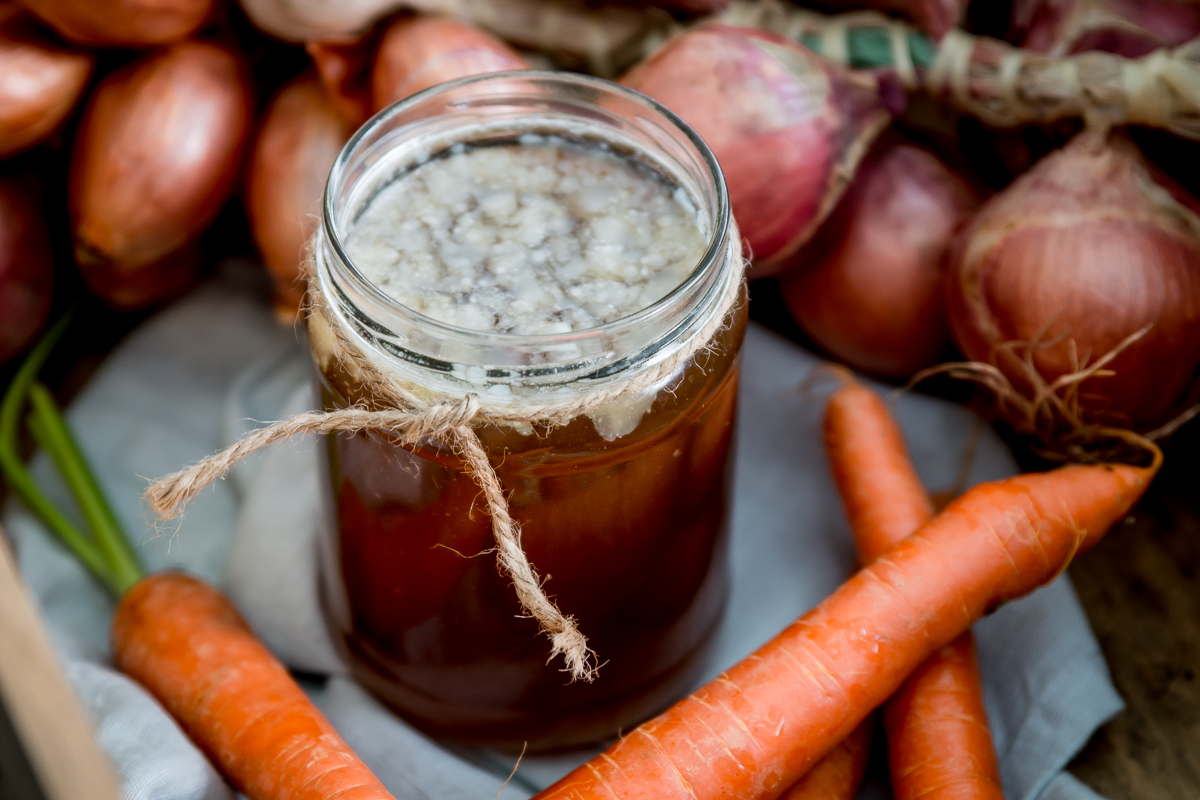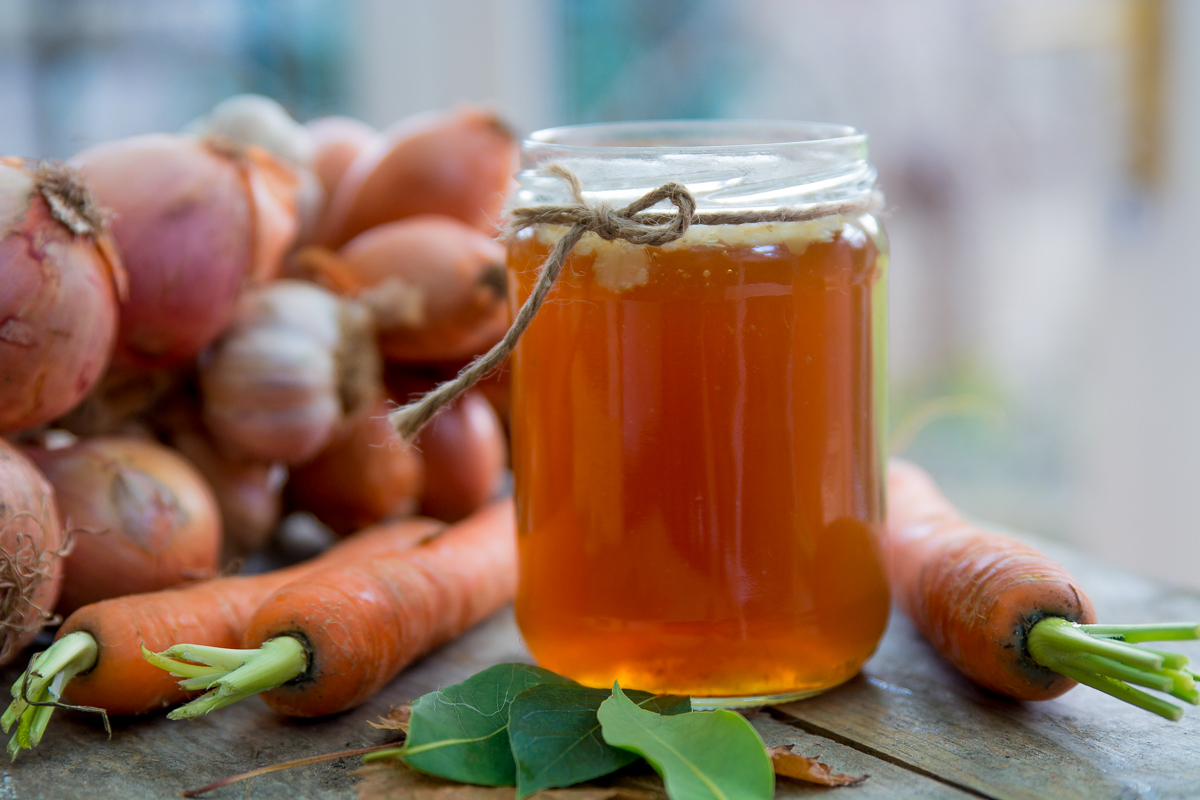What’s in Bones That Makes Bone Broth So Good for You?
Through the process of slow cooking the bones and several tissues around the bone, various nutrients and healing compounds such as collagen, gelatin and various amino acids become bioavailable. Additionally, bone broth contains bioavailable minerals that the body can easily absorb including, calcium, magnesium, phosphorus, silicon, and sulfur.
Bone broth is also rich in various other healing compounds like chondroitin sulfate, glucosamine, and MSM. These nutrients, along with others, are what give bone broth its wonderful health benefits.
Here are the Main Benefits of Bone Broth
1. Protects Joints: Bone broth is the number one natural source of gelatin and collagen, an important protein responsible for healthy joints and cartilage. As we age, collagen production and synthesis diminishes, resulting in joints and tissues that regenerate less. The highly absorbable collagen in bone broth is one easy way to help restore cartilage around the joints. Additionally, gelatin provides the body with the raw material needed to form and preserve the bones. This helps take the stress off the joints.
2. Improved Digestive Function: Gelatin is also beneficial for improving the health of the digestive system. First, gelatin helps to maintain a healthy microbiome, which reduces inflammation in the digestive tract. Additionally, bone broth helps to assist the production of HCL (hydrochloric acid), which is necessary for good digestive function.
3. Promotes Healthy Skin: Glowing skin, hair, and nails – good health is usually reflected in strong, shiny hair and nails and in smooth, clear skin. Bone marrow contains gelatin (collagen) which is transferred into bone broth and into you when you consume it. Regular consumption of collagen/gelatin from bone broth is associated with reduced appearance of wrinkles, fine lines, dryness, inflammation and other signs of skin-ageing.
4. Supports Immune System Function: We all know by now that 80% of the body’s immune system lies in the gut. And bone broth helps to support healthy immune function via healing a leaky gut. Leaky gut develops when undigested food enters the bloodstream through a leaky gut wall and the immune system senses these foreign bodies and attacks them. The problem with this is that every time a person eats, the body sends off an immune response, causing chronic inflammation and immune hyperactivity. Collagen in bone broth is healing and coating the mucus membranes of the gastrointestinal tract and by restoring health to the gut, inflammation is regulated and so is the immune system.
5. Detoxification: Bone broth helps the body in the detoxification process by promoting digestion. Before the body goes through detoxification, it first goes through digestion, metabolism, assimilation and then lastly, detoxification. So the secret to healthy detoxification, is health digestion. Furthermore, bone broth contains proline, glycine and potassium. These all promote cellular detoxification of the liver; improving its ability to remove toxins and secret antioxidants. Additionally, bone broth supplies nutritional sulfur and glutathione, which are necessary for phase II detoxification. Healthy detoxification means less oxidative stress, which means less disease and more graceful aging.
6. Improved Metabolism: In addition to detoxification abilities, the glutathione and the amino acids in bone broth are important for various aspects of the metabolism, including developing and repairing muscle tissue, regulating bone mineral density, and the synthesis and absorption of nutrients. One most important amino acid in bone broth; glycine, is necessary for the conversion of glucose into useable energy, which every organ in the body needs, especially hair follicles, various muscles and other mini-organs. So, it can be helpful for hair growth, muscle building, and decreased signs of ageing by improving the body’s ability to utilise antioxidants. Then another amino acid – glutamine – helps energise the body by delivering nutrients and nitrogen into the cells. Lastly, arginine in bone broth improves circulation, which helps to carry nutrients to cells, which is necessary for muscle and tissue health and recovery.
Bone Broth is great for cooking up rice, quinoa or braising vegetables and making batches of soups, curries and stews.

How to Make Bone Broth
If you want to reap the benefits of bone broth, then you’ll need real home-made bone broth. For those who are not a fan of cooking, you can purchase some quality organic bone broths from various local markets or and even online; although I recommend making it fresh!
Choosing Bones for your Bone Broth:
You can purchase raw bones from a butcher, ask for the bones from grass-fed/free-range animals. If you make a roast that contain bones, save the bone(s) to make bone broth. If you cook a chicken, save and use the carcass.
When purchasing bones for making homemade bone broth, it’s best to get a variety of bone types which will ensure you’re getting bone marrow, cartilage, and gelatin in your broth.
If you wish – you can roast bones first before making bone broth, but roasting is totally a taste preference and is not required.
Step #1: Place bones (fresh, frozen, or roasted) into a large stock pot or crock pot and cover with cold filtered water. Make sure all the bones are covered, but still leave plenty of room for water to boil. Add 1 white or red onion, a couple of carrots, and 2-3 celery stalks to the pot.
Step #2: Add two tablespoon of an acidic substance (eg. apple cider vinegar, wine, or lemon juice) to the water prior to cooking. The acid will help draw out important nutrients from the bones.
Step #3: If you cook on the hob – cover your pot with a lid and bring to the boil. Reduce the heat and simmer, lid on, for at least 3-4 hours for chicken and 6-7 for beef or lamb, skimming off any foam that rises to the top. The longer the bones simmer, the more nutrients are released.
Step #4: The best option is to use slow cooker and cook long until bones begin to crumble! Cook chicken bones for at least 6 to 24 hours (up to 48 hours). Beef bones can cook for 12 to 48 hours. A long and slow cooking time is necessary in order to fully extract the nutrients in and around the bones. You may need to add additional hot water as the broth simmers to keep the bones covered.
Step #5: If you wish – add additional vegetables and/or seasonings such as sea salt, pepper, herbs and peeled garlic cloves to the pot 1-2 hours before finishing. You can add a bunch of fresh dill and parsley 10-15 minutes before removing from heat.
Step #6: Once broth is ready, remove from heat and allow broth to cool. Remove the solids, strain through a fine mesh strainer, and reserve the broth. If there was meat on the bones, you can pick this out to use in a soup.
If your broth becomes thick and jelly-like – this is exactly what you need! That means it contains a significant amount of gelatin (collagen). When you heat up your broth, it will turn back into liquid form.
Broth will keep in the fridge for up to a week. Divide your batch between a few containers. I personally use paper cups for freezing my broth.

